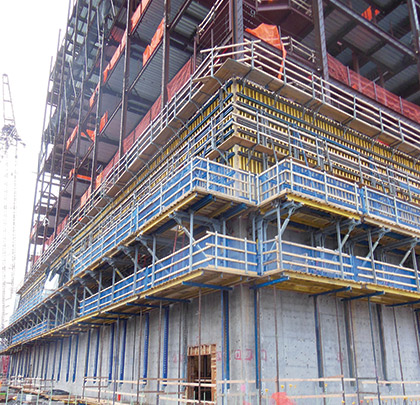Winter time provides some special requirements for concrete constructions. These are some practical tips for using formwork in low temperatures with a special attention to the appropriate formwork panel.
CHOOSING THE APPROPRIATE FORMWORK
The choice of the formwork might influence the outcome of the concrete—especially during cold weather conditions. For example, issues like thermal conductivity, absorptive capacity, and surface texture of the formwork panel (rough, smooth, structured) play a role, but also the environmental conditions the formwork panel endures. So, low temperatures could necessitate additional technical measures for the formwork panels and their usage.
Here are some notes for the use of the formwork panels and their handling at low temperatures:
- During cool/cold weather conditions, wooden panels should be preferred to steel formwork, as panels made of wood feature a lower thermal conductivity and with it, a higher insulating effect. This keeps the fresh concrete temperature at the heat resulting from hydration better and within the construction component. In the market, there are absorbent and non-absorbent panels available.
The thicker the wooden core of a formwork panel, the higher the effect of insulation. Doka had some testing done on that topic together with the FH Johanneum in Graz, Austria. The temperature reading at a construction site during testing was 41 degrees F. The test compared a wooden formwork panel to a steel formwork, both measured on a 12-inch thick wall. With such low temperatures, additional insulation should be installed. - Using absorbent formwork panels/formwork material made of wood, the saturation with water should be considered: Do these panels store a lot of water/humidity? Respectively, if they are saturated with water, then their insulation effects are also decreasing and they dissipate heat from the young concrete.
- During cold weather conditions, a light “bleeding“ of the concrete—a light separation of water out of the concrete—could appear and concrete mixtures that reacted pretty well during higher environmental temperatures could tend to release some water. Water absorbing panels are the choice here.
- Lightly rough, structured panels tend less to show some “creeping water effects” than very smooth and even panels.
- Very smooth panels might stress marbling effects on the concrete surface, while (lightly) rough or structured panels could minimize and reduce marbling and clouding effects.
- Low temperatures may cause a brittleness of the material used on plastic-coated panels. This brittleness of the material could lead to splintering while driving nails into the panel. Also, keep the panels ice-free before applying the concrete release agent. Snow and ice, that possibly even contains de-icing components, should be removed carefully.
- The best way to store panels is protected from the environmental conditions and from wetness, thus elevated on squared timber and covered with plastic sheets. However, the air circulation should be considered in order to avoid some fungal decay of the panels.
- Walking on panels during cool weather conditions could cause sliding action. For this reason, you should always pay extra attention when moving on panels.
- Extended curing periods must be followed. During winter times, there are often critical drying conditions that favor the appearance of dark discolorations on the concrete surface. The execution of a fair-faced concrete surface is quite difficult and problematic during winter times and can only be performed with some increased effort and complexity.
Keep these items in mind when using formwork panels during winter times:
- If possible, use wooden panels at low outside temperatures.
- With very low outside temperatures, use additional insulation on the formwork panels.
- High water absorption using absorbent panels decreases the insulation.
- Lightly rough or structured panels may minimize marbling and clouding effects.
- A higher risk of water separating from the concrete mixture is possible.
- Keep panels ice-free and store them protected, but ventilated.
- There is a risk of brittleness of the plastic coating/plastic panels; pay attention while driving nails into the panels.
- Keep the higher effort for fair-faced concrete in mind during winter time. ■
For More Information: For more information about the choosing the appropriate formwork for your project during the cold weather months, visit www.doka.com.
_________________________________________________________________________
Modern Contractor Solutions – December 2015
Did you enjoy this article?
Subscribe to the FREE Digital Edition of Modern Contractor Solutions magazine.



